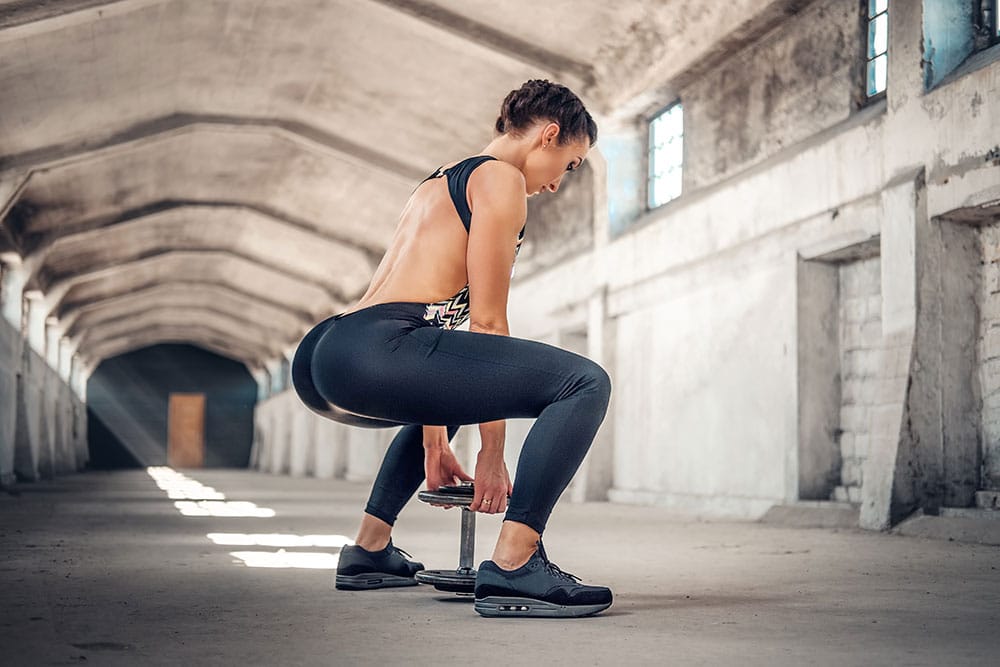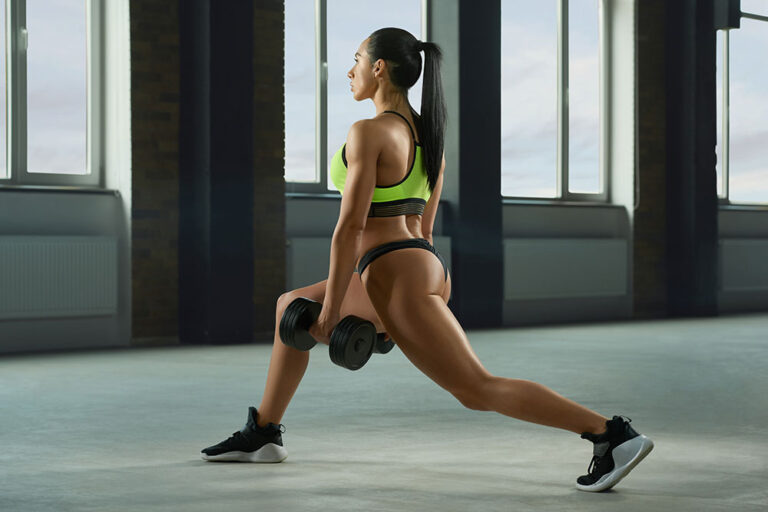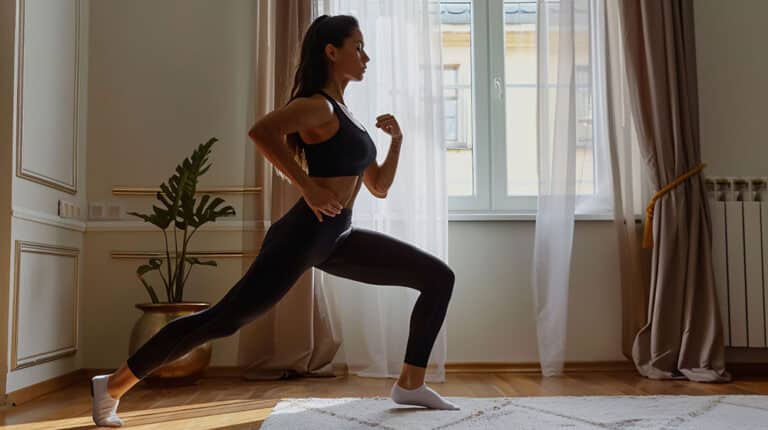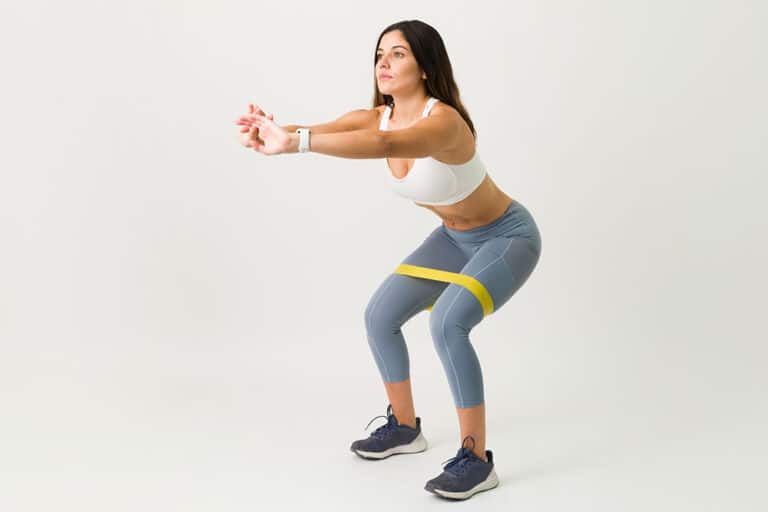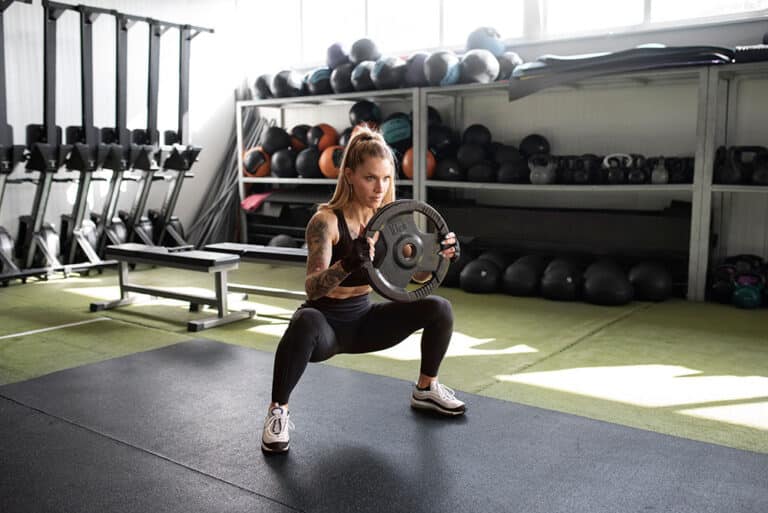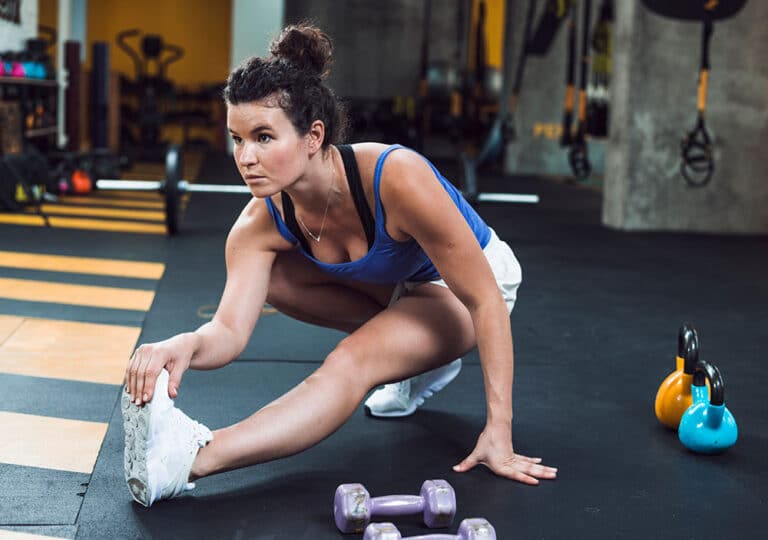Building Leg Strength
Embarking on a bodyweight leg challenge involves understanding the significance of leg exercises and how to effectively incorporate key movements like squats and lunges into your routine.
Importance of Leg Exercises
Leg workouts are a fundamental part of a balanced fitness regimen, offering numerous benefits like enhanced strength, stability, and athletic performance. Strong leg muscles are essential as they support the body’s balance and contribute significantly to overall fitness. Exercises such as squats, lunges, and deadlifts are recommended to maximize performance. For those starting with bodyweight exercises, these movements help build foundational strength before progressing to added resistance like dumbbells.
Research has shown that bodyweight exercise can effectively build muscle and improve aerobic capacity, muscle endurance, and lower-body power even without external weights. This makes it a suitable method for beginners and provides a versatile way to maintain leg strength.
Incorporating Squats and Lunges
Squats and lunges are the primary movement patterns for bodyweight leg exercises, targeting multiple muscle groups and promoting functional strength.
Squats
The squat is often considered the crown jewel of lower body exercises. It primarily engages the muscles in the hips and legs while also demanding core stabilization, thus strengthening the core muscles as well (Healthline). For a detailed tutorial, check out our guide on how to do bodyweight squats.
| Workout | Muscles Targeted | Key Benefits |
|---|---|---|
| Bodyweight Squat | Quadriceps, Hamstrings, Glutes, Core | Enhances overall strength, improves balance, and increases lower body power |
Lunges
Lunges are equally effective and versatile, known for enhancing stability and muscle coordination. Varied lunge types add different challenges and focus on different muscle groups, enriching the overall impact of the workout. For more on different lunge variations, see our article on bodyweight lunge variations.
| Workout | Muscles Targeted | Key Benefits |
|---|---|---|
| Forward Lunge | Quadriceps, Hamstrings, Glutes | Boosts coordination, strengthens lower limbs, and enhances functional movement |
| Reverse Lunge | Quadriceps, Hamstrings, Glutes | Reduces knee stress, engages core, strengthens lower limbs |
Incorporating these exercises into a daily routine not only builds leg strength but also improves muscle tone, stability, and performance. For those seeking more variety, additional exercises can be added to create a comprehensive training program, as discussed in our article on quick leg workout no equipment.
Remember, integrating these movements correctly within your routine can help achieve optimal results. For personalized advice, speak to a fitness expert or refer to guides on how to build leg muscle without weights and leg workout frequency bodyweight.
For further reading on leg exercises, have a look at:
Beginners Leg Workouts
Starting a bodyweight leg challenge can be a fantastic way to build strength, improve stamina, and enhance your overall health. Let’s explore two foundational leg exercises perfect for beginners: chair squats and jump squats.
Chair Squats for Beginners
Chair squats are highly recommended for beginners to master the proper form of a bodyweight squat. Using a chair provides security and a reference point, helping prevent falling backward while squatting (Healthline).
How to Perform Chair Squats
- Setup: Stand in front of a chair with your feet shoulder-width apart.
- Position: Ensure your back is straight, chest lifted, and arms extended forward for balance.
- Descent: Slowly lower your body by bending at your knees and hips, aiming to touch the chair with your bottom lightly.
- Ascent: Push through your heels to return to the standing position.
| Sets | Repetitions | Frequency |
|---|---|---|
| 1-2 | 8-12 | Every 2-3 days |
For more details on squats, check out our guide on how to do bodyweight squats.
Learning Jump Squats Safely
Jump squats are a plyometric exercise that involves using the natural elasticity of muscles and connective tissues to help with explosive movement. This exercise requires multiple sets of standard squats before attempting for safety.
How to Perform Jump Squats
- Setup: Stand with your feet shoulder-width apart and arms at your sides.
- Descent: Lower your body into a squat position, keeping your chest up and back straight.
- Explosive Jump: Push through your heels to jump up explosively, extending your legs fully while airborne.
- Landing: Land softly on your feet and immediately lower back into the squat position to absorb the impact.
| Sets | Repetitions | Frequency |
|---|---|---|
| 1-2 | 8-12 | Every 2-3 days |
Learning proper technique is crucial for jump squats to prevent injuries. For further guidance on plyometric exercises, visit our article on plyometric exercises for legs.
Beginners in resistance training should aim to gradually progress to two to three sets per exercise, consisting of eight to 12 repetitions every second or third day. As you progress, you might find yourself ready to take on more advanced exercises within your bodyweight leg challenge journey.
Advanced Leg Exercises
For individuals aiming to take their leg workouts up a notch, advanced exercises like hip thrusts and step-ups offer a powerful way to enhance strength, stamina, and overall leg performance in a bodyweight leg challenge.
Hip Thrusts for Glute Strength
Hip thrusts are highly effective for targeting the glute muscles. A 2019 study published in The Journal of Strength and Conditioning Research found that hip thrusts might be more effective than squats at enhancing glute strength (Outside Online). They can be performed using body weight alone or progressed to a single-leg hip thrust for a greater challenge.
How to Perform Hip Thrusts:
- Sit on the floor with your upper back against a bench or sturdy surface.
- Bend your knees and place your feet flat on the ground, hip-width apart.
- Drive your hips upward by squeezing your glutes, keeping your upper back in contact with the bench.
- Pause at the top, making sure your thighs are parallel to the ground, and then lower your hips back down.
For detailed instructions and further tips, check out our guide on morning leg exercises.
| Exercise Variation | Repetitions | Sets |
|---|---|---|
| Bodyweight Hip Thrust | 12-15 | 3 |
| Single-Leg Hip Thrust | 10-12 per leg | 3 |
Step-Ups for Lower Body Power
Step-ups are another excellent exercise for building lower body strength and power. According to a 2020 study published in the Journal of Sports Science & Medicine, step-ups are one of the best exercises for strengthening the lower body (Outside Online). They primarily work the quadriceps, hamstrings, glutes, and calves.
How to Perform Step-Ups:
- Find a stable platform or bench about knee height.
- Place one foot on the platform while keeping the other foot planted on the ground.
- Drive through the heel of the foot on the platform to lift your body upwards until the standing leg is fully extended.
- Lower back down to the starting position with control and repeat on the other leg.
Consistency in this exercise will improve not only leg strength but also stability and balance.
| Exercise Variation | Repetitions | Sets |
|---|---|---|
| Standard Step-Up | 10-12 per leg | 3 |
| Alternating Step-Up | 15-20 | 3 |
Performing these advanced leg exercises regularly can significantly enhance muscle tone, performance, and overall fitness. Always incorporate a proper warm-up and utilize heat protectant for hair straightening before starting your routine to minimize the risk of injury. For more information on various leg exercises and their benefits, explore our guides on leg exercises while traveling and leg exercises for bad knees.
Enhancing Leg Stability
Strengthening leg stability is crucial for enhancing overall physical performance and preventing injuries. Exercises like heel slides can boost hamstring strength, which is essential for various activities, while improving balance and stability ensures safer movement.
Heel Slides for Hamstring Strength
Heel slides are an excellent exercise for targeting the hamstrings, critical muscles for activities like climbing, running, and hiking. This exercise can be performed on a slippery surface, such as hardwood floors with socks or using sliding discs.
How to Perform Heel Slides:
- Lie on your back with your knees bent and feet flat on the floor.
- Slowly slide one heel forward until your leg is almost straight, keeping the other knee bent.
- Slide the heel back to the starting position.
- Repeat with the other leg.
| Exercise | Repetitions | Sets |
|---|---|---|
| Heel Slides | 10-15 per leg | 3 |
Incorporating heel slides into your bodyweight leg challenge can significantly boost your hamstring strength. For more leg-strengthening exercises, check out our guide on how to build leg muscle without weights.
Importance of Balance and Stability
Balance and stability are fundamental components of overall fitness. They not only improve performance in sports and activities but also reduce the risk of injuries. Functional exercises, which engage multiple muscles and joints, are particularly effective in enhancing balance and stability.
To incorporate balance and stability training into your routine, consider these exercises:
- Single-Leg Stands: Stand on one leg for 30 seconds, switch legs.
- Heel-to-Toe Walk: Walk in a straight line placing one foot directly in front of the other.
- Lateral Leg Raises: Stand upright, raise one leg to the side, and hold for a few seconds.
| Exercise | Duration/Repetitions | Sets |
|---|---|---|
| Single-Leg Stands | 30 seconds per leg | 2 |
| Heel-to-Toe Walk | 10 steps | 3 |
| Lateral Leg Raises | 10-15 per leg | 3 |
For more exercises to enhance balance and stability, explore our section on leg strengthening for runners.
Training for leg stability should be done with caution to avoid overtraining and injuries. Including rest days, light training, and stretching sessions is essential (Old School Calisthenics). Discover varied leg exercises and routines in our article on quick leg workout no equipment.
Enhancing leg stability through targeted exercises will contribute to greater leg strength and overall physical fitness, building a solid foundation for your [bodyweight leg challenge].
Leg Workout Benefits
Engaging in a bodyweight leg challenge consistently offers numerous benefits. Understanding these advantages can motivate you to incorporate regular leg exercises into your fitness routine.
Muscle Tone and Performance
Maintaining muscle tone and enhancing performance is vital for any fitness enthusiast. Leg workouts such as squats, lunges, and deadlifts engage major muscle groups, helping to boost athletic performance and develop a balanced physique (Healthline). Ignoring leg workouts can lead to imbalanced strength, reduced stability, limited mobility, and decreased muscle mass.
| Leg Exercise | Primary Muscles Worked |
|---|---|
| Squats | Quads, Glutes, Hamstrings |
| Lunges | Quads, Glutes |
| Deadlifts | Hamstrings, Glutes, Lower Back |
Consistent leg exercises are essential for maintaining muscle tone and performance. Integrating activities like bodyweight squats and bodyweight lunge variations can help to keep your leg muscles in top condition. Even if a full workout isn’t possible, aiming for at least 15 minutes of physical activity can preserve and enhance muscle tone.
Health and Fitness Benefits
Leg workouts contribute to overall health and fitness by engaging large muscle groups, which offer a foundation for healthy movement patterns, injury prevention, and chronic condition management (Healthline). Exercises like squats, lunges, and deadlifts are particularly beneficial.
Key benefits of leg workouts include:
- Improvement in overall athletic performance
- Enhancement of balance and stability
- Promotion of healthy movement patterns
- Injury prevention
- Management of chronic conditions such as arthritis, heart disease, and diabetes
Leg exercises also stimulate the release of essential hormones, such as cortisol, testosterone, and human growth hormone (HGH) (Healthline):
| Hormone | Function |
|---|---|
| Cortisol | Aids in stress response, enhances fat metabolism |
| Testosterone | Repairs muscle proteins, builds skeletal muscle |
| HGH | Promotes muscle growth, boosts immunity, increases fat metabolism |
Strong leg muscles create a strong, stable foundation that benefits various movements, including upper-body activities. Incorporating a holistic approach to fitness that includes lower-body training is crucial for overall strength, speed, and stability. To explore more about specific leg exercises such as calf exercises without weights and wall exercises for legs, check out our related articles.
Consistently focusing on leg workouts enhances both muscle tone and overall health, ensuring that your lower body remains strong and functional.
Leg Exercise Safety
Safety is paramount when it comes to leg exercises, especially during a bodyweight leg challenge. Understanding when to rest and when to seek professional advice can help prevent injuries and enhance your fitness journey.
Knowing When to Skip a Workout
It’s crucial to recognize when it’s best to avoid a workout. Exercising when very sore, injured, or unwell can exacerbate problems. According to Healthline, it’s wise to skip leg workouts if experiencing:
- Extensive muscle soreness
- Potential injuries
- Illness symptoms like chest congestion, stomachache, dry cough, fever, extreme tiredness
Minor symptoms like sneezing, a runny nose, or a sore throat may not necessarily require skipping a workout, but it’s advisable to reduce the intensity. Pushing too hard during illness can slow down recovery or lead to more severe injuries.
Consulting a Fitness Expert
Before starting any new exercise program, especially if you’re new to fitness or have medical concerns, consulting a fitness expert or physician is recommended. This is especially important if you:
- Are overweight
- Are over the age of 40
- Have a pre-existing medical condition
- Haven’t exercised in a long time
According to Better Health VIC, seeing a doctor before embarking on a new fitness regimen can help identify potential risks and tailor a program that fits your health needs.
For more guidance on specific exercises and tips on safe workouts, check out our articles on:
- how to do bodyweight squats
- bodyweight lunge variations
- quick leg workout no equipment
- leg exercises for bad knees
- leg workout frequency bodyweight
Prioritizing safety will not only help you achieve your fitness goals effectively but also ensure a sustainable and injury-free fitness journey.
- About the Author
- Latest Posts
Johnnie D. Jackow Sr., the founder and CEO of Total Body Fitness, Worldwide, has a long-standing career in the fitness industry. He began as a certified personal trainer in the mid-90s and soon after authored his first weight loss book in 1998. This led to the launch of Total Body Fitness, Nationwide in the USA at the same time. Johnnie gained recognition as the fitness guru of his time, running infomercials on local TV late at night in Houston, Texas. Over the years, he has helped more than 40,000 individuals from all over the world achieve their health and fitness goals. With over 60,000 hours of documented training in integrative functional medicine, he completed his PhD in human physiology in 2010. His primary objective is to assist people in reaching their health and fitness goals through alternative approaches rather than relying solely on conventional medicine and pharmaceutical drugs. Today, with almost three decades of experience under his belt, Johnnie continues to be a leader in health and fitness.

